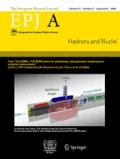Abstract.
We report on a calculation of higher electromagnetic multipole moments of baryons in a non-covariant quark model approach. The employed method is based on the underlying spin-flavor symmetry of the strong interaction and its breaking. We present results on magnetic octupole moments of decuplet baryons and discuss their implications.
Similar content being viewed by others
References
A.M. Bernstein, C.N. Papanicolas, AIP Conf. Proc. 904, 1 (2007) hep-ph/0708.0008.
L. Tiator, D. Drechsel, S.S. Kamalov, S.N. Yang, Eur. Phys. J. A 17, 357 (2003).
G. Blanpied, Phys. Rev. C 64, 025203 (2001).
A.J. Buchmann, E. Hernández, A. Faessler, Phys. Rev. C 55, 448 (1997).
A.J. Buchmann, E.M. Henley, Phys. Rev. C 63, 015202 (2001).
V. Pascalutsa, M. Vanderhaeghen, S.N. Yang, Phys. Rep. 437, 125 (2007)
M.N. Butler, M.J. Savage, R.P. Springer, Phys. Rev. D 49, 3459 (1994)
M. Kotulla, Phys. Rev. Lett. 89, 272001 (2002).
G. Morpurgo, Phys. Rev. D 40, 2997 (1989).
A.J. Buchmann, R.F. Lebed, Phys. Rev. D 62, 096005 (2000)
G. Dillon, G. Morpurgo, Phys. Lett. B 448, 107 (1999).
A.J. Buchmann, E.M. Henley, Phys. Rev. D 65, 073017 (2002). In tables I and II, replace $C$ by $2C$.
T.W. Donnelly, I. Sick, Rev. Mod. Phys. 56, 461 (1984).
If two of these had the same particle index, spin commutation relations would reduce them to a single Pauli matrix.
F. Gürsey, L.A. Radicati, Phys. Rev. Lett. 13, 173 (1964)
For ground-state baryons an allowed operator $\Omega$ must transform according to one of the irreducible representations found in the product $\bar{\mathbf{56}} \times \mathbf{56} = \mathbf{1} + \mathbf{35} + \mathbf{405} + \mathbf{2695}$. Here, the $\mathbf{1}$, $\mathbf{35}$, $\mathbf{405}$, and $\mathbf{2695}$ dimensional representations, are respectively connected with zero-, one-, two-, and three-body operators. Because the $\mathbf{2695}$ occurs only once, there is a unique three-quark magnetic octupole operator.
E.M. Henley, W. Thirring, Elementary Quantum Field Theory (McGraw-Hill, New-York, 1962).
Author information
Authors and Affiliations
Additional information
U.-G. Meißner
Rights and permissions
About this article
Cite this article
Buchmann, A.J., Henley, E.M. Baryon octupole moments⋆ . Eur. Phys. J. A 35, 267–269 (2008). https://doi.org/10.1140/epja/i2007-10565-4
Received:
Accepted:
Published:
Issue Date:
DOI: https://doi.org/10.1140/epja/i2007-10565-4


